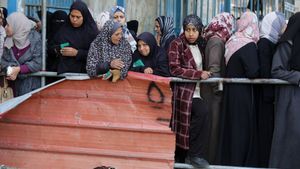JAKARTA - February 1, 2021, will be a new milestone in the history of the Islamic finance industry in Indonesia. This is because the government plans to officially introduce Bank Syariah Indonesia (BSI) as the new identity as a result of the merger of PT Bank Syariah Mandiri (BSM), PT Bank Rakyat Indonesia Syariah Tbk. (BRIS) and PT Bank Negara Indonesia (BNI Syariah).
BSI itself is said to be the largest Islamic banking institution in Indonesia and is projected to be in the top 10 in the world. Meanwhile, the total assets from the merger of the three state-owned banks are projected to reach IDR 240 trillion with a core capital of IDR 20 trillion.
With these asset capabilities, BSI is included in the category of commercial bank for business activities (BUKU) III. The government, through the Head of the Project Management Office (PMO) for the Merger of BUMN Sharia Banks, Himbara Hery Gunardi, gave a signal that efforts to upgrade the Indonesian Sharia Bank business will be carried out in the not too distant future.
"We hope to advance to BUKU IV in 2022," he said.
For information, based on Financial Services Authority Regulation No. 6 / POJK.03 / 2016 Regarding Business Activities and Office Networks Based on Bank Core Capital, the government divides into four categories of banks based on their core capital structure.
First, BUKU I bank with this capital is less than IDR 1 trillion. Both BUKU II are banks with core capital of at least IDR 1 trillion-IDR 5 trillion.
The third is BUKU III with a core capital of at least Rp. 5 trillion and less than Rp. 30 trillion. And the last is BUKU IV, which has a core capital of more than Rp. 30 trillion.
Furthermore, Hery, who is also appointed by the government as the President Director of Bank Syariah Indonesia, admitted that the company will have more flexibility in penetrating the market if it has full service development rights.
"We will encourage massive digital use in order to serve every customer need," he said.
How big is BSI compared to other Islamic banks in Indonesia?Referring to the last Sharia Banking Statistics (SPS) report released by the OJK, as of October 2020, it was stated that all assets of Islamic banks in Indonesia (excluding Islamic BPRs) amounted to IDR 571.1 trillion.
Meanwhile, BSI's assets are said to be IDR 240 trillion. This means that Indonesian Sharia Banks have assets that are almost equivalent to all the assets of a national Islamic bank when combined.
Then, the number of BSI customers is 14.9 million with a total national sharia bank customer of 29.9 million people. In terms of automated teller machines (ATMs), BSI is known to have 1,785 units out of 2,943 ATMs of all Islamic banks.
Then, BSI has 1,200 branch offices and outlets, and a total workforce of 20 thousand. Meanwhile, OJK data states that all banking institutions labeled sharia in Indonesia are known to have 2,349 branch offices with 55 thousand employees.
In terms of performance, Islamic banking institutions can also be said to be able to survive in a pandemic situation like today.
Over the past year, bank credit growth is known to have contracted to minus 2.41 percent. This figure is very different from the performance of Islamic banking financing which is still growing by 9.5 percent.
Meanwhile, the four state-owned banks that are members of the State Bank Association (Himbara), namely Bank Mandiri, BRI, BNI, and BTN, were only able to increase slightly by 0.6 percent.
5 challenges in developing the Islamic economyThe Financial Services Authority said the sharia industry has the potential to grow on a large scale. However, the authorities found five main challenges that must be resolved immediately in order to encourage industries that are in accordance with Islamic principles to increase immediately.
"The first is how we can increase our market share," said Chairman of the OJK Board of Commissioners Wimboh Santoso in a webinar on Tuesday, January 19.
In his notes, the proportion of total Islamic financial assets is only around 9.9 percent. Meanwhile, the other 90.1 percent are controlled by conventional financial institutions.
The second is related to low financial literacy. Wimboh said the Islamic literacy and inclusion index was only around 8.9 percent and 9.1 percent. Meanwhile, national financial literacy and inclusion amounted to 28 percent and 76 percent.
"The third obstacle is the limited differentiation of sharia business or products," he said.
Then, another challenge for the sharia economy is the inadequate adoption of technology and the inadequate fulfillment of human resources (HR).
On this occasion, Wimboh also explained that the Islamic financial industry continues to experience relatively stable growth, both in the Islamic banking sector, the Islamic non-bank financial industry (IKNB), and the Islamic capital market despite the pandemic situation.
"The Islamic financial industry is expected to play an optimal role in supporting national economic growth. We will achieve this by integrating the financial services sector in the development of the halal industry and the Islamic economic ecosystem, "concluded Wimboh Santoso.
Positive signal from Bank IndonesiaBank Indonesia (BI) said that new credit / financing will increase in the first quarter of 2021. The projection was revealed after the monetary authority found the results of a banking survey which stated that the weighted net balance (SBT) of new credit disbursements in the first quarter of 2021 was 49.4 percent or increased. from the fourth quarter of 2020 which amounted to 25.4 percent.
"It is estimated that new credit disbursement in the first quarter of 2021 will be driven by working capital loans, followed by investment credit and consumption credit," said Head of the BI Communication Department Erwin Haryono in a press release, Tuesday, January 19.
Meanwhile, credit growth in the fourth quarter of 2020 is estimated to remain limited, influenced by growth in investment credit. However, the standard of lending in the first quarter of 2021 is not expected to be as strict as the previous period.
This is indicated by the Lending Standard Index (ILS) of 0.4 percent, lower than 3.2 percent in the previous quarter.
"Aspects of disbursement policies that are not expected to be as tight as the previous quarter include the credit ceiling and credit period," he said.
Furthermore, the survey results indicate that respondents are still optimistic about credit growth for the entire 2021 period.
"Respondents predict credit growth in 2021 of 7.3 percent on an annual basis. This optimism is driven, among others, by monetary and economic conditions, as well as the relatively well-maintained risk of lending, "concluded Erwin.
The English, Chinese, Japanese, Arabic, and French versions are automatically generated by the AI. So there may still be inaccuracies in translating, please always see Indonesian as our main language. (system supported by DigitalSiber.id)













